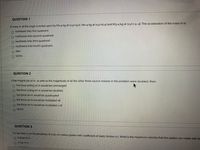Question
answer question 2

Transcribed Image Text:QUESTION 1
A mass m at the origin is acted upon by M1-4 kg at (xy)-(4.0), M2-4 kg at (xy)-(0,4) and M3-4 kg at (x.y)-(-4.-4). The acceleration of the massm is:
Inortheast (into first quadrant)
northwest (into second quadrant)
southeast (into third quadrant)
southwest (into fourth quadrant)
zero
NOTA
QUESTION 2
If the magnitude of m as well as the magnitude of all the other three source masses in the problem were doubled, then:
o the force acting on m would be unchanged
o the force acting on m would be doubled.
o the force on m would be quadrupled
o the force on m would be multiplied x8
o the force on m would be multiplied x 16
O NOTA
QUESTION 3
A5 kg mass is on the periphery of a 50 cm radius platter with coefficient of static friction 0 1. What is the maximum velocity that the platter can rotate with be
2.234 m/s
Expert Solution
This question has been solved!
Explore an expertly crafted, step-by-step solution for a thorough understanding of key concepts.
This is a popular solution
Trending nowThis is a popular solution!
Step by stepSolved in 3 steps with 1 images
